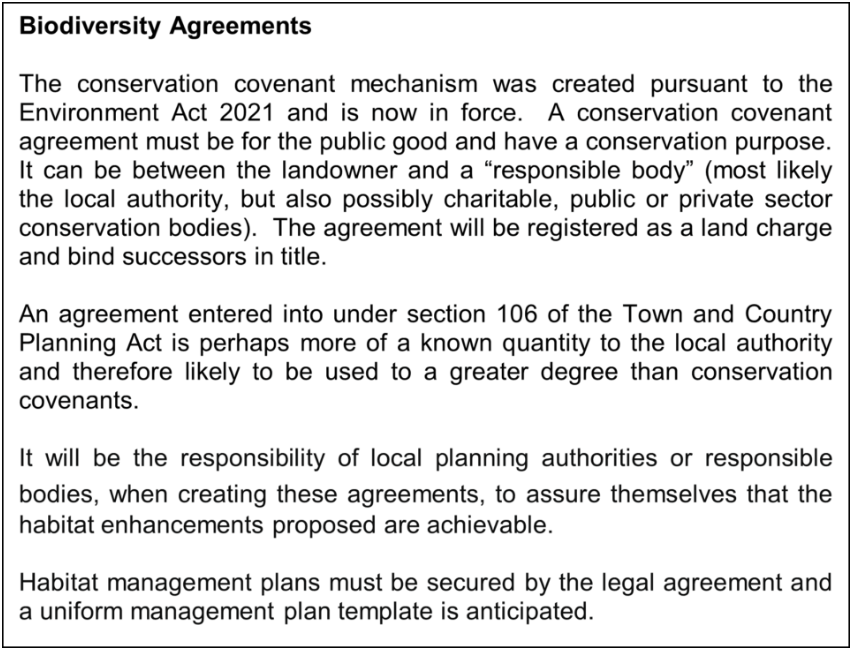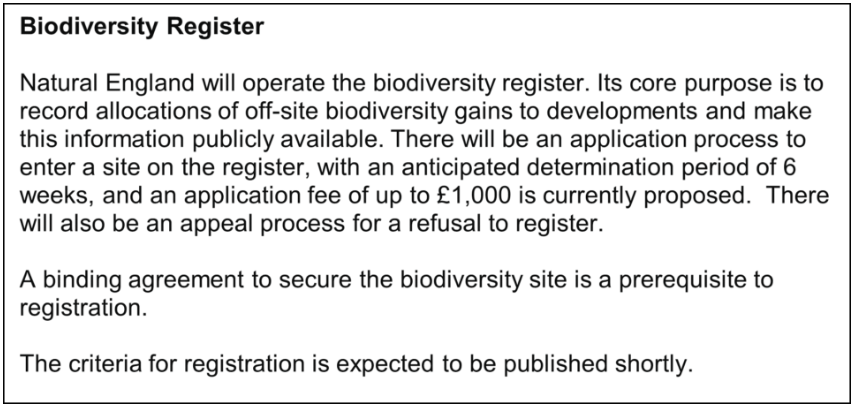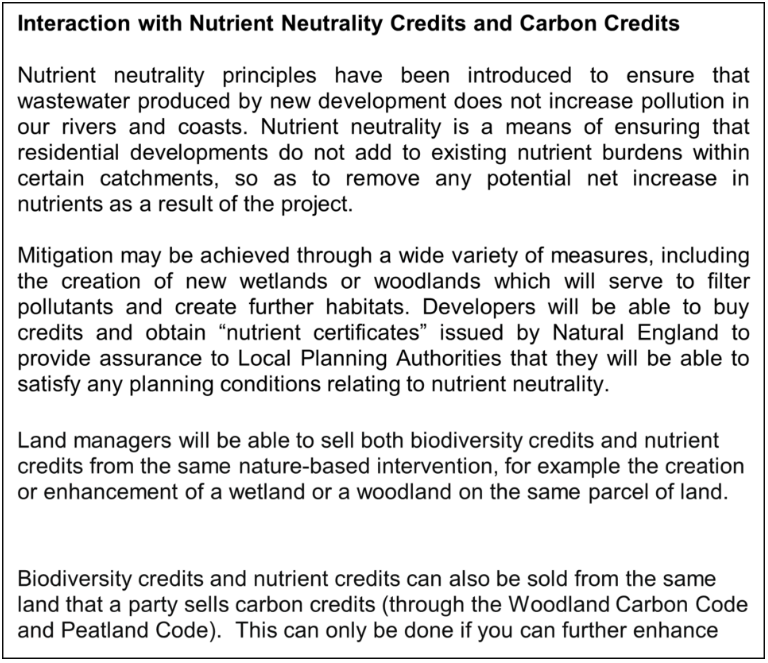It has been well documented that the world is facing multiple environmental problems. One such issue is that of biodiversity loss as populations grow and urbanisation takes hold. England has sought to challenge this global threat at the local level through the imposition of far more rigid biodiversity net gain requirements in their planning system.
Long-term biodiversity targets in England include the restoration or creation of in excess of 500,000 hectares of wildlife-rich habitat by 2042. The mechanism to achieve this, if successful, could accordingly represent a precedent for other nations and a method replicated at a far greater scale.
Biodiversity Net Gain
The preservation and improvement of biodiversity is not a new concept in England. Public authorities in England have a duty to have regard to conserving biodiversity as part of their policy and decision making, and this is established in policy and statute.
However, the Environment Act 2021 has introduced far more specific and targeted biodiversity measures with a requirement to deliver 10% biodiversity net gain on new (with limited exceptions) development sites.
Biodiversity net gain is measured using a specially designed metric (essentially a computer programme created by Natural England (a government body) that will calculate the value of a habitat in units providing a uniform scoring system across all development sites). This metric will determine the biodiversity value of the proposed development site (before it is developed) and in turn determine the the amount of habitat creation needed to achieve the 10% net gain.
The metric will consider the site, quality, location, distinctiveness and condition of the existing land and intertidal habitats, including hedgerows, rivers and streams. Each type of habitat will be given a score. The development of land will in most cases impact these habitats and the developer will be required to identify how a 10% increase on the original unit score can be achieved, and then incorporate that into his plan.
The government’s clear preference is for the developer to create the required biodiversity on-site (for example through the creation of dedicated areas of open biodiversity space in the form of wildflower meadows with hedgerow and tree planting and so on). However, this will not always be possible. Developers can also meet the requirement through off-site biodiversity habitat creation if the developer has access to additional land. A system to generate and trade biodiversity units (or credits as they are also termed in the context of the sale and purchase of units) is proposed for situations where the developer does not have access to additional land.
These units/credits so acquired will be linked to other biodiversity sites managed and maintained by third parties that will in turn allow the developer to fulfil their enhanced biodiversity requirement without actually providing the habitat on their development site.
The Biodiversity Credit Market
At first, a statutory biodiversity credit scheme will allow the government to sell biodiversity credits for national projects. These are going to be intentionally priced at a high/disproportionate rate as they are ultimately intended to be a last resort. Indeed, the government has made it clear that these types of credits are to be phased out.
The government has proposed that the preferred mechanism should be a private marketplace that will allow parties (be they public authorities or private entities and individuals) to create their own biodiversity habitats and sell credits. The government will not determine the price and open market competition will dictate the sale terms. Sellers will bear the risk that the price is sufficient to cover the costs of creating, enhancing, monitoring and maintaining the habitat.
This habitat creation could take the form of developers creating biodiversity habitats on their own development sites and disposing of excess credits beyond the 10% requirement. Alternatively, an entity could create a separate purpose-built habitat (a “habitat bank”), funded ultimately through the disposal of credits.
The price of either a statutory credit or a credit sold on the market is currently unknown. However, in a consultation document from January 2022 the government (based on a market analysis study) estimated that there would be an annual demand within the market for around 6,200 off-site biodiversity credits with a market value in the region of £135 million (the price being in the region of £20,000 to £25,000 per unit/credit).
This private credit market will not be wholly unregulated. Certain stipulations must be complied with, including:
- The biodiversity habitat (be it created on-site or off-site) must be secured and preserved for a minimum period of 30 years. This must be accomplished by means of a legal agreement, most likely via conservation covenants or an agreement entered into under Section 106 of the Town and Country Planning Act 1990. A planning condition may also be possible for on-site biodiversity net gain.
- The habitat created to secure the credit must be registered on the biodiversity register, which will impose specific registration requirements and fees.
- The seller must demonstrate that there are no significant impacts on priority habitats
- Local authorities cannot direct buyers towards their land in preference over other suppliers to the market, unless there are clear ecological justifications for doing so.
- In reference to the disposal of excess gains on a development site, the government is cautious to ensure the 10% requirement does not represent a cap on all sites. The ‘excess’ gains must be identified clearly in the original development’s biodiversity gain plan and there must be genuine additionality for the excess credits sold.
- Habitat created or enhanced after 30 January 2020 will be eligible for registration and sale of the associated biodiversity gains, provided it meets the other criteria of the biodiversity gain site register. Habitat created or enhanced before this date will need to be re-baselined from 30 January 2020 to ensure that only biodiversity credits created or enhanced after this date can be sold.
- The owner of the habitat bank will need to record and provide suitable monitoring information to demonstrate that the initial works to create or enhance the habitat have been completed by a given date.
- The whole habitat bank need not be secured by a legal agreement (as noted above) from day one. However, a phased agreement approach will be required for each part of the site as it is the subject of a disposal to a developer.
- Suppliers of biodiversity credits will be able to sell to developers anywhere in England, provided that the use of those credits is appropriate for the development in question and the distance between the development and the off-site habitat is properly accounted for in the biodiversity metric. The clear inference is that the closer the off-site habitat, the better, but there still appears to be a mis-match on this point between the legislation (which does not require gains to be on-site/local) and the guidance (which sets out a clear preference for this).
What Comes Next and why is this so important?
The 10% biodiversity net gain requirement will be mandatory in England from November 2023 onwards and will therefore be a key consideration for developers and local planning authorities alike going forward.
Further guidance, policy and legislation on biodiversity net gain is expected ahead of implementation. There are already a number of pilot habitat banks led by Wildlife Trusts, as well as the creation of the Future Parks Accelerator, which is a collaboration between the National Lottery Heritage Fund, National Trust and the Department for Levelling Up, Housing and Communities.
A lot undoubtedly needs to happen by November 2023 for the biodiversity credit scheme to represent an effective tool for developers and local planning authorities. The government very recently published a long-awaited consultation response, which clarified many of the points discussed above around biodiversity credits. It also confirmed the scope of exemptions (some small-scale developments will be exempt, others will benefit from a six-month delay, but previously developed sites will not be exempt). However, it still leaves many questions unanswered and details to be provided, including how enforcement will be managed as between Natural England and local authorities, particularly since Natural England has indicated that it will not be undertaking direct enforcement of biodiversity net gain itself.
These measures will affect developers, local planning authorities and other public and private bodies, and they will all need to traverse this complex yet potentially hugely beneficial system.
Please get in touch with us if you have any queries, and our expert team will be happy to assist.







